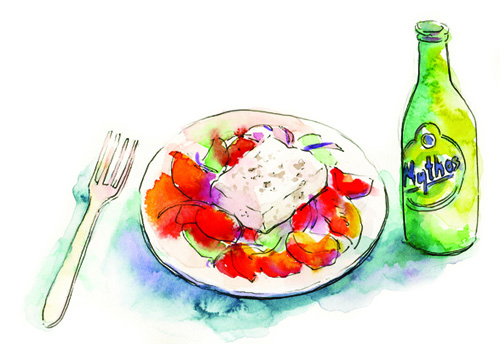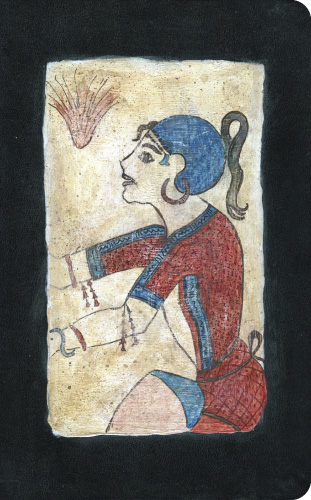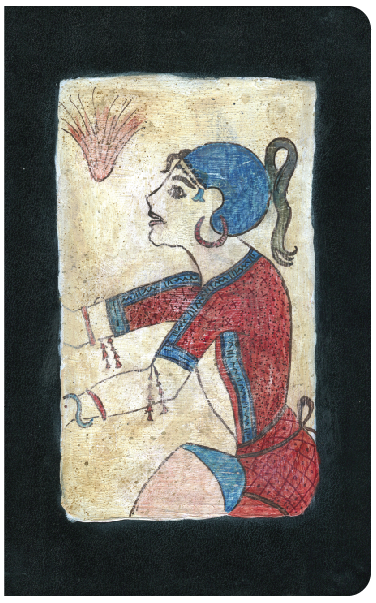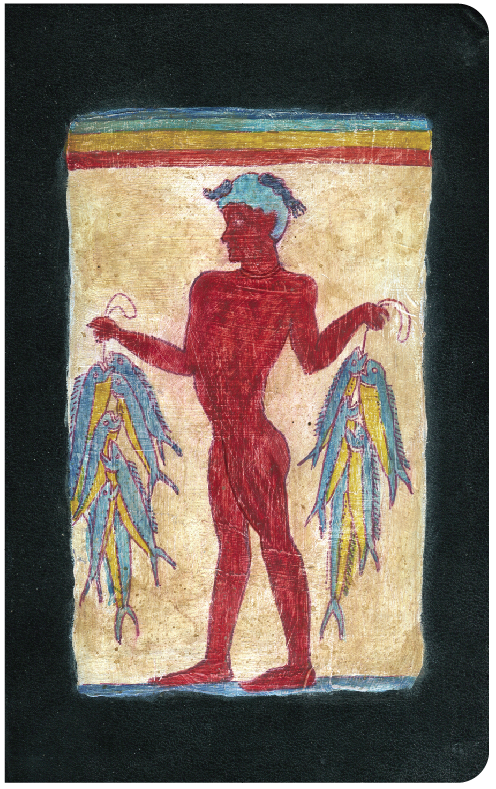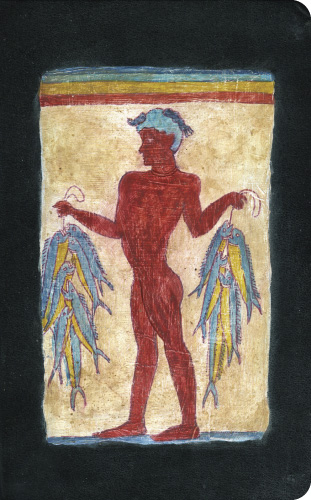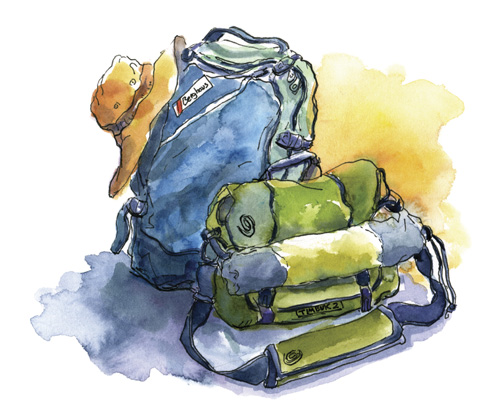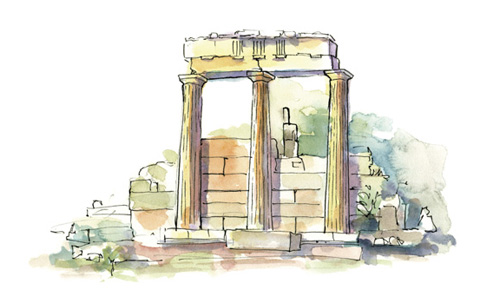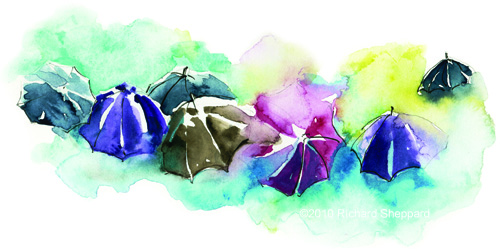Our first evening in Athens, we settled into an outdoor cafe for an early dinner. I ordered an open faced gyro, starting with a Greek salata: ripe tomatoes, tangy vinaigrette, red onions, kalamata olives, and a slab of seasoned feta. While I was enjoying my salad, a little girl, maybe eight-years old, approached us from the street carrying an accordion. She played a single note on the instrument and said in English, “Money please.†When we shook our heads no, she turned, without a blink of an eye or expression of disappointment, to the next table and repeated. It was very amusing.
Category: Greece
Hand Painted Moleskine Sketchbook
I painted this Moleskine sketchbook cover using an image from an Akrotiri wall painting. Akrotiri was an ancient city on the island of Santorini in Greece, and was destroyed when the volcano (upon which it was located) erupted circa 1,600 BC. The wall paintings uncovered by archeologists have an amazing modern quality about them. I find their sense of design and beauty similar in many ways to today’s artistic sensibilities. The painted subjects are outlined, and the resulting faceted shapes are filled with flat washes of color. Although this type of graphic style is more symbolic than naturalistic, a crocus is obviously a crocus, and a goat is definitely a goat. The figures represented in the wall paintings also have this same flat, graphic style but they have an extra level of detail with decorative patterns painted across their clothing. One of my personal favorites is a beautiful girl out gathering saffron from crocuses in her beaded, Minoan costume, a flounced kilt tied at her waist. It’s ironic that the event that destroyed this ancient civilization saved the wall paintings for posterity. If the Thera volcano had not erupted 3,600 years ago, preserving the frescos in volcanic ash, we would not have representations of this civilization today.
How (and Why) I Paint my Moleskine Sketchbook Covers
After spending months drawing in my sketchbook, I’m a bit reluctant to finish the last page. The completed book is filled with places I’ve traveled, friends I’ve met, and delicious food I’ve eaten, all wrapped up in memories. But starting a new sketchbook is exciting too. I often think about the places I’ll visit and the people I’ll meet while drawing within its pages. If I’m lucky, I’ll discover a new drawing or painting technique that I’ve never tried before. Although the pure enjoyment of drawing is my main purpose for sketchbooking, I intend to improve my drawing abilities along the way.
I used to draw in Moleskine sketchbooks but now I make my own. Either way, the technique for painting the cover is the same.
- For the base, I paint gesso on the front of the book in a loosely painted rectangular shape, then let it dry. I repeat this two more times, lightly with sandpaper between applications to remove the bumps and brush strokes. Sometimes I add a small dab of color to the gesso to soften its brightness.
- Then, using a dampened paper towel, I rub a small amount of earthy acrylic colors on top of the base to provide visual texture and depth.
- Next, I sketch my subject on the cover in pencil and then draw over my pencil lines in permanent ink. If I make a mistake, I can use sandpaper to remove the offending line and then rub more color into the resulting white area.
- Once my drawing is complete, I paint the resulting shapes with color. Sometimes, for texture, I spatter watered down acrylic paint over the finished piece with a toothbrush to add depth and texture. After letting the cover dry overnight, I’m ready for my next great sketching adventure.
These two sketchbook covers were drawn from photos of the archeological wall paintings of Akrotiri on the island of Santorini, Greece. The original wallpaintings are thousands of years old.
Hand Painted Moleskine Sketchbook Cover
I hand paint my Moleskine sketchbook covers in acrylic to personalize each one. This is one of two sketchbooks I painted and used while in Greece last October. The cover painting is a copy of an Akrotiri wall painting from the archeological site on the island of Santorini. The Minoan civilization that created the wall painting flourished over 3,600 years ago.
Watercolor of My Travel Bags
This is a painting of my backpack and messenger bag (containing all my art supplies) that I used while traveling in Greece. I bought the backpack many years ago when I lived in London and I still use it regularly. The messenger bag was a recent purchase for this Greece trip and it worked out well. The brand is Timbuku. It has lots of internal compartments to separate my supplies and overall construction seems sturdy. I only have two complaints about this bag. One, the trim on the flap tends to stick to the velco and fray. The second problem is the two water bottle holders on the sides don’t hold my water bottles very well. A good art supply bag is hard to come by these days because most of them are so poorly made. Overall, I would recommend the Timbuku bag. My wide brim hat comes in handy when the place I choose to draw doesn’t come with a shade tree.
Sanctuary of Asclepius
I was amazed at how many people were actually visiting the Acropolis in October. So many in fact that it was hard to find a good place to paint. This situation was intimidating and kept me from drawing on my first day in Greece. This sketch is of the Sanctuary of Asclepius which is one of many ruins along the path up the Acropolis and a place fewer people tended to congregate.
Olympian Zeus
On my second day in Athens I finally got over jet lag enough to start painting. My first painting was the ruins of Olympian Zeus. The site was closed at the time but I found a comfortable spot to set up shop just just outside the fence. Using a Molskine watercolor sketchbook, I first created a line drawing in ink and then finished it with watercolors.
Syntagma Square Metro, Athens
While traveling in Greece, I discovered it can rain a fair amount in October. My dad and I drove around the mainland and visited several islands for a total of three weeks last year and experienced 4-5 days with showers. Although there were a couple of times I had to hide my sketchbook from the wet weather, It generally wasn’t a problem. The best part was the crystal clear views the rain provided, especially on Santorini were I could see for miles looking out over the Aegean from on top of the caldera.
